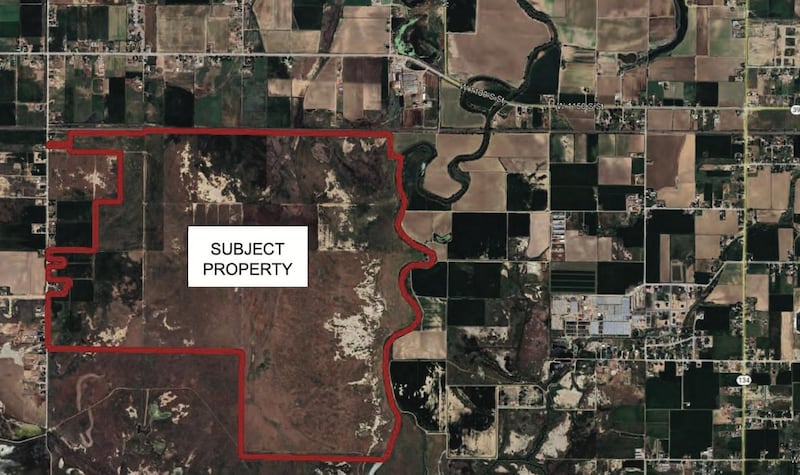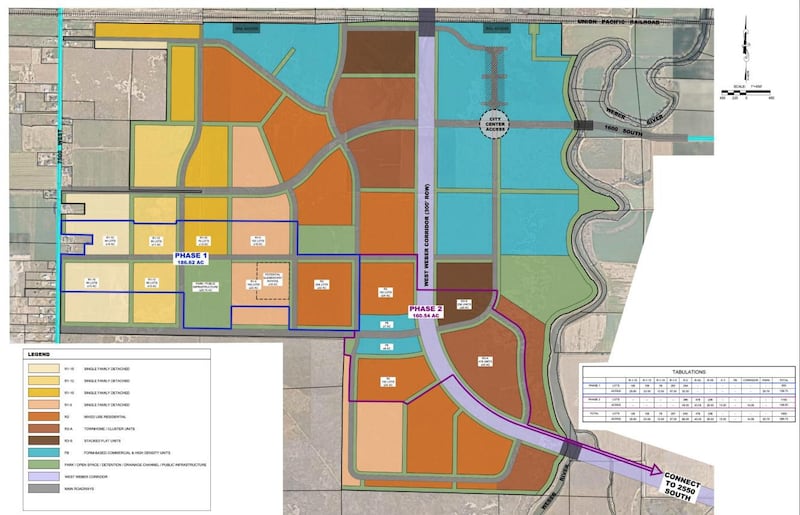A massive new community is in the works in the open expanses of western Weber County, where growth has been strong — though it may be years before development begins in earnest.
Weber County Commissioner Gage Froerer likened the envisioned locale to Vineyard and Daybreak, planned communities in Utah and Salt Lake counties, respectively, and said it’s perhaps the biggest development project in the county in recent years.
Over the long haul, developers envision as many as 13,200 housing units and 38,500 new residents spread across a 1,415-acre expanse west of the Weber River and south of the Union Pacific rail line that parallels the east-west 12th Street corridor.
“It’s a 30-, 40-, 50-year project at best. We don’t really expect any housing units to go in for several years just because of the infrastructure requirements we placed on them,” including bridges and pedestrian crossings over the Weber River and the Union Pacific line, Froerer said Thursday. It could take five to 10 years for the first homes to take shape, he predicts, while market forces will be one of the largest factors bearing on how plans proceed.
Reps from the firms behind the plans, Lehi-based Flagship Homes and an entity called Fenix Development, didn’t respond to queries seeking comment. County commissioners last week, though, approved the rezone of the open land to allow for new housing and the development agreement for the community, called Westbridge Meadows.
The project area sits west of Ogden, northeast of the Ogden Bay Waterfowl Management Area and south of the much-larger Weber County inland port project, an industrial proposal sprawling across around 9,000 acres.

Housing development has been steady in western Weber County, where open expanses of land remain, amid population growth and as Ogden and other cities to the east fill up. The Westbridge Meadows project stands out, however, because the vision is for an entire new community with a range of housing types and a commercial center, not just a single subdivision or cluster of homes.
“It’s probably going to become its own city at some point in time,” Froerer said, noting that the developers were involved in the creation of Vineyard. “Basically, go in and plan that community, put in infrastructure that supports affordable housing, put in commercial, again, so you can live, work, eat, have restaurants, etc., within walking distance of your house.”
With projects like the inland port initiative, residents of the planned locale could theoretically work nearby, reducing the need to travel south to Salt Lake or Davis counties for work, thereby easing congestion on I-15, Froerer added.
‘A good spot for it’
Development in the western expanses of Weber County can be a delicate topic for some, nostalgic for the agricultural roots of the area. Froerer, though, said the land where Westbridge Meadows would take shape has not been used for agricultural production, due to the properties of the soil. Concentrating new development in and around the site, he added, allows other, more productive land to stay in use for agricultural purposes.
People from the area familiar with the properties of the land understand “that if you’re going to put housing out there, this is a good spot for it,” he said. “I think most people, hopefully, are realistic enough to know that if we don’t start planning now for housing for our kids and grandkids, it’s never going to happen.”
Addressing the project at the Sept. 2 meeting, when Weber County commissioners approved the rezone and development agreement for the project, Charlie Ewert, a county planner, said the project could lead to increased water flow to the nearby Ogden Bay Waterfowl Management Area. Excess water would have to be directed away from the development area.
What’s more, as the area grows, developers have earmarked two locations in Westbridge Meadows as potential mass-transit stops.
It will take “quite a bit of residential dwelling units” for state transit authorities to consider expanding to the area, Ewert said. “But as we know from the Daybreak project, you get enough ... development pressure, you’ll get extensions of those transportation facilities, whether it’s light rail or (bus rapid transit) or whatever it may be.”

While the project, in the works since at least late 2023, may be ambitious, Froerer noted during last week’s meeting, the strong demand for housing in Utah. “We know that Weber County, along with the state of Utah, is in desperate need of affordable or attainable housing,” he said.
A development plan crafted by Flagship Homes in February envisions as many as 13,199 homes on the 1,415-acre parcel, which would house an estimated 38,541 people if fully built out. Approximately 240 acres would be reserved for open space, including three regional parks and 168 acres of trail and other corridors, some along the Weber River.
The housing would include single-family homes, townhomes, condominiums and apartments that cater to a range of income levels.
“The intent is to entice residents to stay within the community as they grow, and expand from renters or first-time homebuyers to move-up housing and custom homeowners. With the recent inland port designations for properties in the area, Westbridge Meadows is ideally situated to provide the convenient housing and commercial components needed for successful large-scale industrial development,” reads the development plan.

